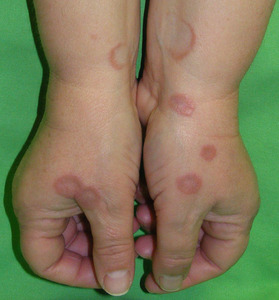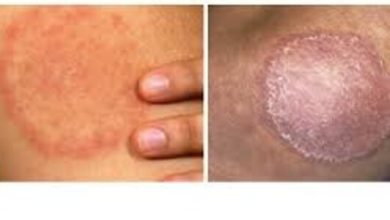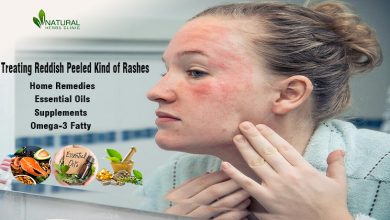Granuloma Annulare in Children: Causes, Myths, and Natural Care Tips

Granuloma Annulare in Children is a fairly uncommon skin condition, and when it appears, it can raise many questions for parents. While the condition is typically harmless, its appearance can be unsettling. Understanding what causes it, clearing up common myths, and exploring natural care tips can help families manage this skin concern with confidence.
In this guide, you’ll find straightforward information about Granuloma Annulare in Children, including the symptoms, possible triggers, and holistic support options. If you’re a parent or caregiver looking for gentle and supportive ways to care for your child’s skin, this will help you make informed choices.
What Is Granuloma Annulare?
Granuloma annulare is a skin condition that often surprises people with its unusual name and harmless but persistent appearance. While it may look concerning at first glance, it is not contagious or dangerous. In most cases, it resolves on its own without leaving lasting damage. Still, understanding what granuloma annulare is, how it presents, and what you can do about it can offer peace of mind and help you manage the condition more effectively.

Common Types of Granuloma Annulare
Granuloma annulare presents in several forms. Identifying the type helps determine its progression and suitable management strategies.
- Localised Granuloma Annulare
This is the most common type. It features small, flesh-toned or pinkish bumps that form a ring, usually less than 5 cm across. It typically appears on the hands, feet, elbows, or knees and often causes no discomfort. Localised GA usually clears up on its own within two years. - Generalised (Disseminated) Granuloma Annulare
Less common and typically seen in adults, this type affects larger body areas, such as the trunk, arms, and legs. The lesions are more widespread and may merge. Generalised GA can last longer and may be associated with systemic conditions like diabetes. - Subcutaneous Granuloma Annulare
This form mainly affects children and results in firm, painless lumps under the skin, often on the scalp, legs, or fingers. Unlike other types, the skin surface may appear normal or slightly reddish. - Perforating Granuloma Annulare
This rare form leads to small bumps that may discharge a clear or yellowish fluid. It is more likely to leave scars and tends to affect the backs of the hands and fingers.
What Causes Granuloma Annulare?
The exact cause of granuloma annulare is unknown. However, researchers believe it results from an immune system reaction that triggers inflammation in the skin. Several factors have been associated with its development, including:
- Minor skin injuries such as insect bites or scratches
- Infections like hepatitis or HIV (rarely)
- Certain medications, including some used for managing high blood pressure or gout
- Chronic conditions like diabetes mellitus or thyroid disease
- Stress, which may act as a trigger in susceptible individuals
Despite these associations, most cases of granuloma annulare occur in healthy individuals without a clear cause.
Related Article: Granuloma Annulare Over the Counter Treatment: Effective Options and Solutions
Symptoms and Appearance
Granuloma annulare usually begins as small, firm bumps that expand slowly and form ring-shaped lesions. These rings may be pink, red, or skin-coloured and often have a clear centre. The rash is generally not painful or itchy, although some people may experience mild discomfort.
In more widespread cases, the lesions can cover larger areas and may be more noticeable. Subcutaneous lumps, when present, are deeper and firmer, without the ring-shaped surface rash.
It’s important to note that although GA looks unusual, it is not contagious and does not pose a health threat.
Recognising Granuloma Annulare in Children
The signs of Granuloma Annulare in Children may differ slightly from case to case. However, common features include:
- Smooth, skin-coloured or slightly reddish bumps
- Ring-shaped or arc-like patterns
- Localised appearance, often on extremities
- Lack of itching, pain, or scaling
In some cases, lesions may fade on their own over time, while in others, they might persist or recur over months or even years.
What Causes Granuloma Annulare in Children?
Granuloma annulare is a skin condition that often appears as ring-shaped patches or bumps. Although it can affect people of any age, children are not immune to it. In fact, the localised type is quite common in younger individuals. This article explores the potential causes of granuloma annulare in children, how it appears, and what parents should know when it comes to identifying and managing this condition.
The exact cause of granuloma annulare remains unclear, especially in children. However, several theories and associations have emerged from medical research. While no single trigger applies to every case, the following factors are often considered in relation to granuloma annulare in children:
1. Immune System Reaction
One of the leading theories is that granuloma annulare results from a delayed immune response. In children, the immune system is still developing and may sometimes overreact to minor irritations or infections. This overreaction can cause the immune system to mistakenly attack the skin, leading to inflammation and the formation of granulomas small clusters of immune cells that form the characteristic ring-shaped lesions.
In many cases, the body’s immune response resolves on its own, which explains why granuloma annulare often disappears without treatment.
2. Minor Skin Injuries or Trauma
Skin injuries such as insect bites, scratches, or even vaccinations may act as a trigger for granuloma annulare in children. Although the injury itself may seem insignificant, it can sometimes lead to localised inflammation that eventually develops into granuloma annulare.
Children are naturally more prone to minor cuts and abrasions due to active play, which may help explain the frequency of this condition in the younger population.
3. Viral Infections
There is some evidence that viral infections may be involved in triggering granuloma annulare. In children, common viral illnesses—such as colds, chickenpox, or even asymptomatic viral infections—may prompt the immune system to react in unusual ways. This immune response may lead to the development of granulomas in the skin.
Although specific viruses haven’t been proven as direct causes, a possible link between viral triggers and the immune response continues to be studied.
4. Genetic and Familial Factors
Some studies suggest a potential genetic link, as granuloma annulare can occasionally run in families. While this is rare, children with a parent or sibling who has experienced granuloma annulare may be slightly more likely to develop the condition themselves. This suggests a possible inherited immune system sensitivity or predisposition.
However, no specific gene has yet been identified as responsible, and familial cases remain uncommon.
5. Allergic or Hypersensitivity Reactions
Although less common, hypersensitivity reactions—such as allergic responses to medications, foods, or environmental irritants—might contribute to the appearance of granuloma annulare in children. Some cases seem to follow exposure to new substances, suggesting that the skin’s response to allergens could trigger the inflammatory process.
That said, true allergic causes are rarely confirmed, and granuloma annulare is generally not classified as an allergic condition.
Related Article: Treating Reddish Peeled Kind of Rashes: Essential Guide for Skin
How Long Does It Last in Children?
The good news is that granuloma annulare in children is often self-limiting. Many cases resolve within a few months to two years without any need for treatment. The skin usually returns to normal without scarring.
In some children, however, the condition may return intermittently or persist longer. If the lesions are widespread, itchy, or cause emotional distress, parents may choose to seek medical advice.
When to See a Doctor
While granuloma annulare is generally harmless, it’s a good idea to consult a doctor or dermatologist in the following cases:
- The rash is spreading quickly or worsening.
- The child is experiencing discomfort or itching.
- The skin lesions last longer than a year.
- You’re unsure if the condition is actually granuloma annulare.
- The child has other symptoms, such as fatigue, weight loss, or fever.
A doctor can usually diagnose granuloma annulare by looking at the skin. In rare cases, a skin biopsy may be needed to confirm the diagnosis.

Managing and Monitoring the Condition
Because granuloma annulare often disappears on its own, treatment is not always necessary. However, some children benefit from:
- Topical corticosteroids to reduce inflammation.
- Cryotherapy (freezing the lesions) for stubborn cases.
- Light therapy (phototherapy), though rarely used in young children.
In most situations, a watch-and-wait approach works well, especially when the lesions are mild and not causing discomfort.
Common Myths About Granuloma Annulare in Children
Granuloma annulare in children can be confusing and even a little worrying for parents when it first appears. This skin condition often causes small, raised, ring-shaped bumps to form on the skin, usually on the hands, feet, arms, or legs. Although it is generally harmless and often resolves on its own, many myths surround this condition. Misunderstandings can lead to unnecessary fear, delayed care, or the use of ineffective remedies.
Let’s break down some of the most common myths about granuloma annulare in children and uncover the facts every parent should know.
Myth 1: Granuloma annulare is a serious or life-threatening disease
One of the most widespread myths is that granuloma annulare is dangerous or even life-threatening. In reality, this condition is benign. It may look unusual or concerning, especially when the rash spreads, but it doesn’t usually cause pain or itching and isn’t linked to cancer or other severe illnesses.
Granuloma annulare does not usually lead to long-term complications. In most cases, the skin lesions clear up without treatment within months to a few years. The main challenge is cosmetic, not medical.
Myth 2: It is contagious
Parents often worry whether their child can spread granuloma annulare to siblings or classmates. This is a common misunderstanding. Granuloma annulare is not infectious or contagious. It cannot be passed through touch, shared clothing, or bedding.
The condition involves an immune reaction within the skin, not a virus, fungus, or bacteria. So there is no risk of transmission from person to person.
Myth 3: Poor hygiene causes granuloma annulare
Another misconception is that the condition results from poor hygiene. Some people wrongly associate any skin abnormality with uncleanliness or improper washing. However, granuloma annulare has nothing to do with dirt, poor grooming, or neglect.
In fact, over-washing or using harsh soaps may irritate the skin and make symptoms more noticeable. Instead, it’s better to use gentle skincare products and moisturisers that keep the child’s skin healthy and comfortable.
Related Article: Preventing Over Production of Leukocytosis- Self-Awareness
Myth 4: Granuloma annulare always needs treatment
Because the appearance of the rash can be alarming, many parents believe treatment is always necessary. In truth, most cases of granuloma annulare in children resolve without any medical intervention.
Doctors may recommend a “wait and watch” approach unless the rash is widespread or affecting the child’s emotional wellbeing. If treatment is pursued, it may include topical steroids, light therapy, or natural care strategies. However, these approaches are mostly aimed at easing appearance rather than curing the condition faster.
Myth 5: It is caused by a bug bite or injury
Some parents notice the rash shortly after a bug bite or minor skin trauma and assume that’s the cause. While small injuries or insect bites may trigger granuloma annulare in some children, they are not the root cause.
Medical researchers believe granuloma annulare is likely related to immune system activity, possibly in response to minor triggers. But it’s not the same as a reaction to a mosquito bite or scrape. It’s more of an internal immune process that happens to show up on the skin.
Myth 6: It’s the same as ringworm
This myth is especially common because granuloma annulare forms ring-shaped lesions that can look similar to ringworm, a fungal skin infection. However, the two conditions are entirely different.
Ringworm is contagious, causes itchiness, and can spread quickly. Granuloma annulare, on the other hand, is not contagious, usually not itchy, and typically causes no discomfort. A doctor can easily distinguish between the two using a skin examination or, if needed, a simple skin test.
Myth 7: Diet causes or cures granuloma annulare
There is no strong scientific evidence that diet causes granuloma annulare or that specific foods can cure it. While a healthy diet rich in vitamins and minerals supports overall skin and immune health, no single food or nutritional deficiency has been proven to cause the condition.
That said, some parents explore anti-inflammatory diets or natural remedies to help manage symptoms. While this may benefit general wellbeing, it should not replace professional medical advice. Always consult a doctor before starting any alternative or restrictive diet for a child.
Myth 8: It’s a sign of an underlying disease
In most children, granuloma annulare occurs on its own without any link to an underlying health condition. However, in adults, there may occasionally be associations with diabetes or thyroid issues.
Because this myth circulates widely online, many parents fear their child may have a hidden illness. Rest assured, for children, granuloma annulare is almost always an isolated skin condition and not a symptom of something more serious.
Doctors may conduct basic tests if the rash is widespread or long-lasting, but this is usually precautionary rather than necessary.
Myth 9: It will leave permanent scars
This skin condition is not known to leave permanent scars. The bumps and rings may fade slowly, especially if the child has had the condition for a long time, but in most cases, the skin returns to normal.
If a child scratches the affected areas excessively (especially if the rash becomes irritated), temporary darkening or slight discolouration may occur. But scarring is not typical.
Gentle skincare and avoiding unnecessary treatments can help support the skin’s healing process.
Myth 10: Natural care and home remedies don’t help
While granuloma annulare often resolves without any intervention, some families choose to explore natural care methods to support the child’s skin and immune health.
Soothing herbal creams (such as calendula), natural anti-inflammatory oils (like chamomile or coconut oil), and gentle stress-reducing practices may have a place in home care. These won’t “cure” the condition but may help reduce irritation or support skin recovery.
Related Article: Skin Bumps Problem: The Trendy Solutions You Need to Try
Can It Be Treated In Children?
Granuloma annulare in children often doesn’t need any medical treatment. In most cases, the rash goes away on its own after a few months without causing long-term problems. However, if the spots are bothering the child or affecting their appearance, a doctor might suggest some treatments to help:
- Topical corticosteroids – Creams that reduce redness and swelling on the skin.
- Cryotherapy – A procedure that freezes and removes the skin lesions, usually used when the rash doesn’t go away on its own.
- Phototherapy – A light-based treatment used in more widespread or stubborn cases.
Even with these options, many parents choose to simply watch and wait, especially since the condition is not harmful and tends to clear up naturally. In the meantime, gentle natural care methods like moisturising, protecting the skin, and using calming herbal remedies—can help support the child’s skin and comfort without strong medications.
Natural Care Tips for Granuloma Annulare in Children
Granuloma annulare in children can appear suddenly, leaving parents puzzled and concerned. Although this skin condition often resolves on its own, seeing ring-shaped rashes on a child’s hands, feet, or legs can be distressing. Thankfully, there are natural care tips that may help soothe the skin, support healing, and reduce discomfort.
We’ll explore gentle, natural approaches to caring for a child with granuloma annulare without relying solely on medication.
1. Keep the Skin Moisturised
Dry skin can aggravate skin conditions and delay healing. Using gentle, natural moisturisers helps maintain the skin barrier and prevent cracking or irritation.
Try:
- Coconut oil: Naturally antibacterial and anti-inflammatory, coconut oil soothes and nourishes the skin.
- Shea butter: Rich in vitamins A and E, shea butter helps hydrate and soften affected areas.
- Aloe vera gel: Aloe is cooling and helps calm inflammation. Choose 100% pure gel with no added alcohol or chemicals.
How to use: Apply a thin layer 1–2 times daily after bathing or when the skin feels dry.
2. Avoid Harsh Skincare Products
Children’s skin is more sensitive, especially when affected by conditions like granuloma annulare. Many soaps, shampoos, and lotions contain irritants that can worsen the condition.
Look for:
- Fragrance-free, dye-free products
- Natural or organic baby soaps
- Mild cleansers (e.g. oatmeal-based or goat’s milk soap)
Avoid:
- Products with alcohol, sulphates, parabens, or strong artificial scents
3. Use Cold Compresses for Comfort
If the affected area becomes itchy or warm, a cold compress can help soothe irritation. This is especially helpful during hot weather or if your child is scratching the area.
How to do it:
- Soak a clean cloth in cool water, wring it out, and place it over the rash for 5–10 minutes.
- You can also use a cold gel pack wrapped in a soft cloth (never place ice directly on the skin).
Repeat as needed, especially before bedtime to help your child rest more comfortably.
4. Try Natural Anti-inflammatory Remedies
Some Granuloma Annulare Remedies may help reduce inflammation and support the skin’s healing process. While not a cure, these can complement a gentle skincare routine.
Options to consider (under medical guidance):
- Chamomile: Used as a tea compress or added to bathwater, chamomile has mild anti-inflammatory properties.
- Calendula: A traditional skin soother, calendula creams or ointments can help calm redness and irritation.
- Colloidal oatmeal baths: Oatmeal helps moisturise and protect the skin barrier. Add finely ground oats to a lukewarm bath and let your child soak for 10–15 minutes.
Always patch-test any new product on a small area of your child’s skin before full use.
5. Support the Immune System Through Diet
Granuloma annulare may be linked to immune function. A healthy, nutrient-rich diet can help support your child’s immune system and overall skin health.
Encourage:
- Fruits and vegetables rich in vitamin C, zinc, and antioxidants (e.g. berries, carrots, leafy greens)
- Healthy fats such as those in avocados, nuts (if age-appropriate), seeds, and olive oil
- Whole grains and lean proteins
Limit:
- Highly processed foods
- Excess sugar
- Fizzy or sugary drinks
A well-balanced diet provides the body with the tools it needs to repair tissue and maintain skin integrity.
6. Encourage Gentle Sun Exposure
In some cases, short periods of sun exposure may help granuloma annulare fade more quickly. Sunlight has natural anti-inflammatory effects and supports vitamin D production.
Tips:
- Let your child play outside during early morning or late afternoon sun for 10–15 minutes.
- Avoid peak sunlight hours (10 a.m.–4 p.m.) to prevent sunburn.
- Always use child-safe, non-toxic sunscreen on unaffected skin.
Consult your healthcare provider before increasing sun exposure, especially if your child has other skin conditions.
Related Article: Granuloma Annulare vs Ringworm: A Simple Guide to Avoid Misdiagnosis
7. Minimise Scratching and Irritation
While granuloma annulare is usually not itchy, some children may feel the urge to scratch, which can damage the skin and lead to infection.
Try:
- Keeping nails trimmed short
- Distracting with toys or calming activities
- Dressing your child in breathable, soft cotton clothing
- Using soothing lotions to reduce any irritation
If scratching becomes a concern, speak to your child’s doctor about natural itch-relief options.
8. Stay Calm and Patient
Granuloma annulare can be persistent but is usually harmless and self-limiting. Natural remedies may not lead to overnight results, but consistent care and a calm environment help.
Children often pick up on their caregivers’ emotions. Staying calm, reassuring, and positive helps your child feel less anxious about their skin changes.
9. Monitor and Keep a Journal
Keep a simple record of when lesions appear or fade. Note any changes in diet, products used, or activities. This may help you and your child’s healthcare provider identify potential triggers or patterns.
Record:
- Dates of flare-ups or improvement
- New foods, illnesses, or skincare products
- Emotional stress (e.g. changes at school or home)
This journal can also help track the impact of natural care strategies over time.
10. Consult Your Healthcare Provider
While natural care can support comfort and healing, always involve a qualified medical professional in your child’s care. They can help confirm the diagnosis, rule out other conditions, and guide you on the safest treatments natural or medical.
Living with Granuloma Annulare: Reassurance for Parents
Discovering Granuloma Annulare in Children can be unsettling at first, especially if the rash seems unusual or long-lasting. However, this condition is typically mild, non-threatening, and resolves on its own.
Your child is not in danger, and there’s no need for drastic treatment unless advised by a medical professional. Most children experience no discomfort, and many outgrow the condition without any lasting impact.
Patience, gentle skin care, and holistic well-being approaches can go a long way in managing the condition calmly.
Final Thoughts
Granuloma Annulare in Children is a benign, self-limiting skin condition that may look alarming but is rarely a cause for serious concern. By understanding its causes and debunking common myths, parents can feel more confident in their response.
Natural care tips such as using plant based moisturisers, encouraging a nutrient-rich diet, and reducing irritants offer a safe and nurturing way to support the healing process. Always consult with your child’s doctor or dermatologist for diagnosis and advice before trying any treatment, natural or medical.
Related Article: Granuloma Annulare Vitamin D: Your Newest Weapon Against Ringed Red Bumps




